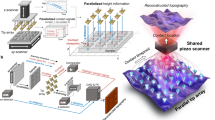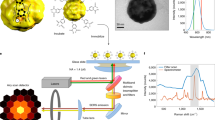Abstract
Optical traps play an increasing role in the bionanosciences because of their ability to apply forces flexibly on tiny structures in fluid environments. Combined with particle-tracking techniques, they allow the sensing of miniscule forces exerted on these structures. Similar to atomic force microscopy (AFM), but much more sensitive, an optically trapped probe can be scanned across a structured surface to measure the height profile from the displacements of the probe. Here we demonstrate that, by the combination of a time-shared twin-optical trap and nanometre-precise three-dimensional interferometric particle tracking, both reliable height profiling and surface imaging are possible with a spatial resolution below the diffraction limit. The technique exploits the high-energy thermal position fluctuations of the trapped probe, and leads to a sampling of the surface 5,000 times softer than in AFM. The measured height and force profiles from test structures and Helicobacter cells illustrate the potential to uncover specific properties of hard and soft surfaces.
This is a preview of subscription content, access via your institution
Access options
Subscribe to this journal
Receive 12 print issues and online access
$259.00 per year
only $21.58 per issue
Buy this article
- Purchase on Springer Link
- Instant access to full article PDF
Prices may be subject to local taxes which are calculated during checkout






Similar content being viewed by others
References
Santos, N. C. & Castahno, M. A. R. B. An overview of the biophysical applications of atomic force microscopy. Biophys. Chem. 107, 133–149 (2004).
Somorjai, G. A. & Li, Y. Impact of surface chemistry. Proc. Natl Acad. Sci. USA 108, 917–924 (2011).
Hoerber, J. K. H. & Miles, A. M. J. Scanning probe evolution in biology. Science 302, 1002–1005 (2003).
Dufrene, Y. F. et al. Multiparametric imaging of biological systems by force–distance curve-based AFM. Nature Methods 10, 847–854 (2013).
Dupres, V. et al. Nanoscale mapping and functional analysis of individual adhesins on living bacteria. Nature Methods 2, 515–520 (2005).
Ludwig, T. et al. Probing cellular microenvironments and tissue remodeling by atomic force microscopy. Pflügers Archiv Eur. J. Physiol. 456, 29–49 (2008).
Wiggins, P. A. et al. High flexibility of DNA on short length scales probed by atomic force microscopy. Nature Nanotech. 1, 137–141 (2006).
Malmqvist, L. & Hertz, H. M. Trapped particle optical microscopy. Opt. Commun. 94, 19–24 (1992).
Ghislain, L. P. & Webb, W. W. Scanning-force microscope based on an optical trap. Opt. Lett. 18, 1678–1680 (1993).
Kawata, S., Inouye, Y. & Sugiura, T. Near-field scanning optical microscope with a laser trapped probe. Jpn J. Appl. Phys. 33, L1725–L1727 (1994).
Florin, E.-L. et al. Photonic force microscope based on optical tweezers and two-photon excitation for biological applications. J. Struct. Biol. 119, 202–211 (1997).
Sugiura, T. et al. Gold-bead scanning near-field optical microscope with laser-force position control. Opt. Lett. 22, 1663–1665 (1997).
Friese, M. E. J. et al. Three-dimensional imaging with optical tweezers. Appl. Opt. 38, 6597–6603 (1999).
Tischer, C. et al. Three-dimensional thermal noise imaging. Appl. Phys. Lett. 79, 3878 (2001).
Pralle, A. et al. Three-dimensional high-resolution particle tracking for optical tweezers by forward scattered light. Microsc. Res. Tech. 44, 378–386 (1999).
Neuman, K. C. et al. Ubiquitous transcriptional pausing is independent of RNA polymerase backtracking. Cell 115, 437–447 (2003).
Bormuth, V. et al. Protein friction limits diffusive and directed movements of kinesin motors on microtubules. Science 325, 870–873 (2009).
Becker, N. et al. Three-dimensional bead position histograms reveal single-molecule nano-mechanics. Phys. Rev. E 71, 021907 (2005).
Koch, M. & Rohrbach, A. Object adapted optical trapping and shape tracking of energy switching helical bacteria. Nature Photonics 6, 680–686 (2012).
Rohrbach, A., Kress, H. & Stelzer, E. H. K. Three-dimensional tracking of small spheres in focused laser beams: influence of the detection angular aperture. Opt. Lett. 28, 411–413 (2003).
Dreyer, J. K., Berg-Sørensen, K. & Oddershede, L. B. Improved axial position detection in optical tweezers measurements. Appl. Opt. 43, 1991–1995 (2004).
Rohrbach, A. et al. Trapping and tracking a local probe with a photonic force microscope. Rev. Sci. Instrum. 75, 2197–2210 (2004).
Friedrich, L. & Rohrbach, A. Improved interferometric tracking of trapped particles using two frequency-detuned beams. Opt. Lett. 35, 1920–1922 (2010).
Seitz, P. C., Stelzer, E. H. K. & Rohrbach, A. Interferometric tracking of optically trapped probes behind structured surfaces: a phase correction method. Appl. Opt. 45, 7309–7315 (2006).
Phillips, D. B. et al. Surface imaging using holographic optical tweezers. Nanotechnology 22, 285503 (2011).
Phillips, D. B. et al. An optically actuated surface scanning probe. Opt. Express 20, 29679–29693 (2012).
Phillips, D. B. et al. Shape-induced force fields in optical trapping. Nature Photonics 8, 400–405 (2014).
Nakayama, Y. et al. Tunable nanowire nonlinear optical probe. Nature 447, 1098–1101 (2007).
Rohde, M. et al. A novel sheathed surface organelle of the Helicobacter pylori CAG type IV secretion system. Mol. Microbiol. 49, 219–234 (2003).
Andersson, M. et al. A structural basis for sustained bacterial adhesion: biomechanical properties of CFA/I pili. J. Mol. Biol. 415, 918–928 (2012).
Jannasch, A. et al. Nanonewton optical force trap employing anti-reflection coated, high-refractive-index titania microspheres. Nature Photonics 6, 469–473 (2012).
Grießhammer, M. & Rohrbach, A. 5D-tracking of a nano-rod in a focused laser beam—a theoretical model. Opt. Express 22, 6114–6132 (2014).
Acknowledgements
The authors thank M. Koch, D. Ruh, A. Seifert and T. Henze for a careful reading of the manuscript and/or for helpful discussions. We also thank B. Waidner for helping with the H. pylori bacteria and C. Müller for support with the SEM-image acquisition.
Author information
Authors and Affiliations
Contributions
L.F. performed the experiments, analysed the data and prepared all the graphs. A.R. initiated and supervised the project. A.R. and L.F. co-wrote the manuscript.
Corresponding author
Ethics declarations
Competing interests
The authors declare no competing financial interests.
Supplementary information
Supplementary information
Supplementary information (PDF 911 kb)
Supplementary information
Supplementary Movie 1 (AVI 3691 kb)
Supplementary information
Supplementary Movie 2 (MOV 1449 kb)
Supplementary information
Supplementary Movie 3 (AVI 5706 kb)
Supplementary information
Supplementary Movie 4 (AVI 3691 kb)
Rights and permissions
About this article
Cite this article
Friedrich, L., Rohrbach, A. Surface imaging beyond the diffraction limit with optically trapped spheres. Nature Nanotech 10, 1064–1069 (2015). https://doi.org/10.1038/nnano.2015.202
Received:
Accepted:
Published:
Issue Date:
DOI: https://doi.org/10.1038/nnano.2015.202
This article is cited by
-
Thermal fluctuations of the lipid membrane determine particle uptake into Giant Unilamellar Vesicles
Nature Communications (2023)
-
Towards non-blind optical tweezing by finding 3D refractive index changes through off-focus interferometric tracking
Nature Communications (2021)
-
Optical rotation conveyor belt based on a polarization-maintaining hollow-core photonic crystal fiber
Optical Review (2020)
-
Indirect optical trapping using light driven micro-rotors for reconfigurable hydrodynamic manipulation
Nature Communications (2019)



